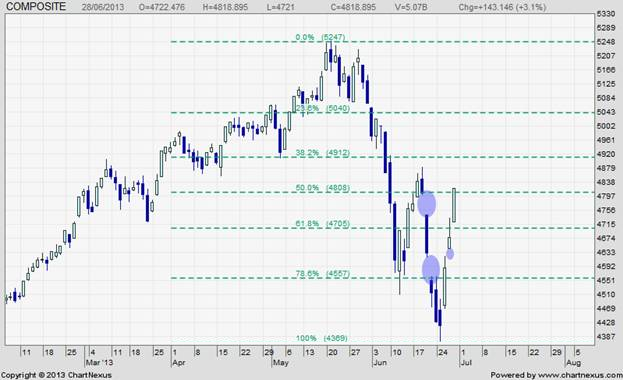Indonesia Composite Index (IHSG): Bearish Trap or Bullish Trap?
Last week, Indonesia's main index (IHSG) rebounded 303 points to 4,818.90. After weeks of foreign outflows, Indonesia finally experienced capital inflows again during the last two days of the week. For example, on Friday (28/06) foreigners bought IDR 960 billion (USD $97.0 million) more Indonesian shares than they sold. However, considering the full week, foreigners still recorded net selling amounting to IDR 1.02 trillion (USD $103 million). Do these last couple of days tell us that the bearish market is over? Lets take a closer look.
It should be remembered that foreigners started to turn their backs to Indonesia's main stock index (IHSG) from early May when Standard & Poor's downgraded Indonesia's BB+ credit rating outlook from positive to stable. Apart from that, it was released that Indonesia's economic growth in the first quarter of 2013 had only reached the level of 6.02 percent. For most countries such a growth number is great, but for Indonesia it was disappointing as GDP growth of 6.3 to 6.5 percent was originally expected. Moreover, talks between the government and parliament regarding the revision of 2013's state budget (RAPBN) were lengthy and difficult last month. In the end, it was agreed that the price of subsidized fuel would be increased, thus resulting in a significant higher inflation assumption. Inflation in 2013 is believed to creep up to 7.2 percent (from the original expectation of 5 percent).
Apart from these domestic issues, the international environment was not at all supportive when Ben Bernanke, chairman of the Federal Reserve, announced his intention to stop the quantitative easing program in 2014 (if economic recovery of the USA continues). This announcement caused most stock indices to fall significantly.
But are these domestic and international factors, which have caused foreign investors to avoid Indonesia's stock market, resolved? No, not yet. In my opinion, the growth of the IHSG last week was mainly due to window dressing or a rebound to fill a gap.

In the above chart it is visible that the two gaps that occurred when the index was corrected have been closed now. In fact, it even caused the existence of a new gap at 4,622 to 4,641. If the IHSG does not break the resistance level of 4,912, then I think the index will move sideways with a possible decline to 4,600 points. Today's release of June's inflation figure will be important. If it shows a high outcome, then it will have a negative impact on the IHSG.
This week, investors need to be cautious. Since the start of May, my advice has been to reduce investors' position in the Indonesian market. At this moment, I do not recommend a similar strategy as it is too late to reduce portfolios now. What I recommend now is to observe carefully which sectors have strong potential within the present context. For example, construction, animal feed and consumption are sectors in Indonesia with strong fundamentals. But is this the right time to enter the market? The IHSG's price to earnings ratio (PER) already reached 16 times now, while the reasonable price of the IHSG this year is between 4,850 and 4,900. Volatility will continue to colour the performance of the IHSG this week and threats of another correction are still high. The support level of the index is 4,600 and if it breaks, the level goes down to 4,400. If it does go down to that level, I recommend to buy. I am still positive that foreign investors will return to Indonesia, but they will not come back quickly. Therefore, it is best to be patient and wait for the release of macroeconomic data first as well as company reports. Lastly, I want to stress not to forget that there is still a gap at 4,620 points now.
David Sutyanto is a research analyst at Jakarta-based First Asia Capital
